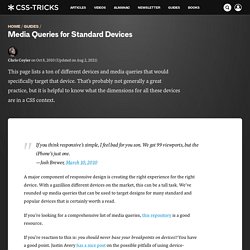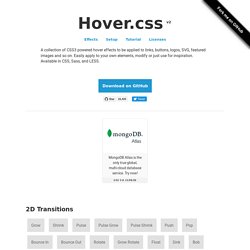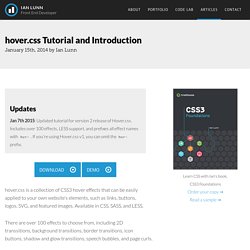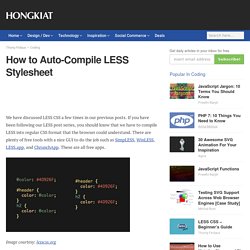

Media Queries for Standard Devices. If you think responsive's simple, I feel bad for you son.

We got 99 viewports, but the iPhone's just one. —Josh Brewer, March 10, 2010 A major component of responsive design is creating the right experience for the right device. With a gazillion different devices on the market, this can be a tall task. We've rounded up media queries that can be used to target designs for many standard and popular devices that is certainly worth a read. If you're looking for a comprehensive list of media queries, this repository is a good resource. If you're reaction to this is: you should never base your breakpoints on devices!!
Phones and Handhelds iPhones Galaxy Phones Google Pixel HTC Phones Nexus Phones Windows Phone Tablets iPads Galaxy Tablets Nexus Tablets Kindle Fire Laptops Media Queries for laptops are a bit of a juggernaut. Wearables Yes, we're going there. Apple Watch @media (max-device-width: 42mm) and (min-device-width: 38mm) { } Moto 360 Watch. Hover.css - A collection of CSS3 powered hover effects.
All Hover.css effects make use of a single element (with the help of some pseudo-elements where necessary), are self contained so you can easily copy and paste them, and come in CSS, Sass, and LESS flavours.

Many effects use CSS3 features such as transitions, transforms and animations. Old browsers that don't support these features may need some extra attention to be certain a fallback hover effect is still in place. Licenses Hover.css is made available under a free personal/open source or paid commercial licenses depending on your requirements. To compare licenses please visit the Ian Lunn Design Limited Store and purchase a commercial license. Personal/Open Source For personal/open source use, Hover.css is made available under a MIT license: Use in unlimited personal applications Your application can't be sold Your modifications remain open-source Free updates Read full license Commercial Commercial License Purchase | Read full license Extended Commercial License Purchase | Read full license.
Hover.css - A collection of CSS3 powered hover effects. Hover.css Tutorial and Introduction - Ian Lunn - Front End Developer. Hover.css is a collection of CSS3 hover effects that can be easily applied to your own website’s elements, such as links, buttons, logos, SVG, and featured images.

Available in CSS, SASS, and LESS. There are over 100 effects to choose from, including 2D transsitions, background transitions, border transitions, icon buttons, shadow and glow transitions, speech bubbles, and page curls. hover.css is a stylesheet containing many different classes, each offering a different hover effect. If you’re comfortable with using CSS, then you most likely can jump straight in to using hover.css without the following tutorial.
If that’s the case, you may like to skip further down into the article where I discuss some of the default CSS and hacks used to improve the appearance of hover.css effects — especially on mobile/tablet devices, browser support, SASS/LESS support and Grunt support. How to Use. Using `npm run` to build and watch with less and browserify. Less/less.js. How to Auto-Compile LESS Stylesheet - Hongkiat. We have discussed LESS CSS a few times in our previous posts.

If you have been following our LESS post series, you should know that we have to compile LESS into regular CSS format that the browser could understand. There are plenty of free tools with a nice GUI to do the job such as SimpLESS, WinLESS, LESS.app, and ChrunchApp. These are all free apps. Image courtesy: lesscss.org However, if for some reason you are not be willing to install yet another app, and are wondering if there is an alternative way, we have a handy workaround for you, without being dependent on additional apps. The compiling process will happen instantly on save, so yes, it is technically similar to how we compile Sass with the watch command. Recommended Reading: LESS CSS – Beginner’s Guide First, let’s open up the Terminal (Mac and Linux); if you are running on Windows you can open Command Prompt. The command line will grab the LESS package and its dependencies.
Handlebars-helper-less. {{less}} handlebars helper.

This helper allows you to use LESS inside style tags in your HTML. By default, the resulting CSS will be rendered inside the <style>... </style> tags of the rendered HTML, but you may alternatively define a destination path using the dest hash option of the helper. {{less}} handlebars helper. This helper allows you to use LESS inside style tags in your HTML. Quickstart In the root of your project, run the following in the command line: npm i handlebars-helper-less --save-dev Registering the helper If you use Assemble choose one of the following approaches to register the helper: Option #1: Gruntfile Define paths to any helpers in the helpers option of your project's Gruntfile: gruntinitConfig assemble: options: helpers: 'handlebars-helper-less' files: {} Option #2: Add to devDependencies and keywords Or, add the helper to the devDependencies of your project's package.json, and then add the name of the module, handlebars-helper-less, to the keywords:
LESS - The Basics. Using LESS, the CSS Preprocessor. How to Use a CSS Preprocessor (LESS)